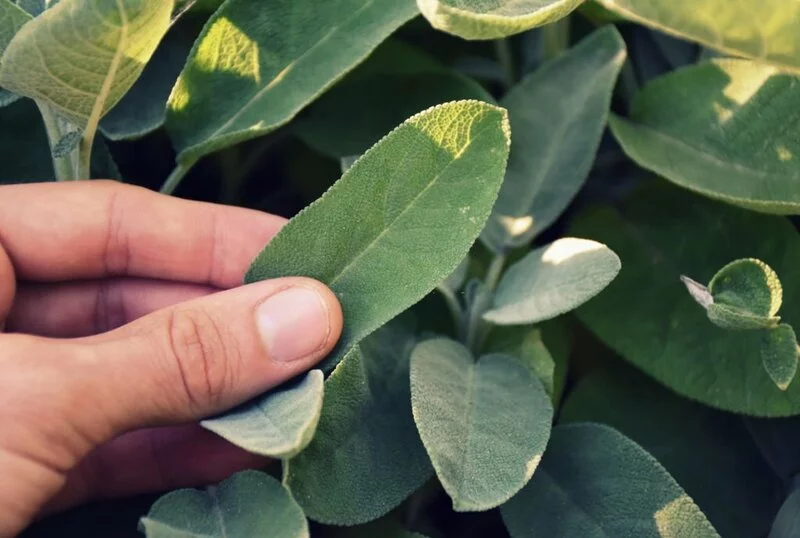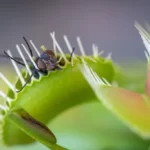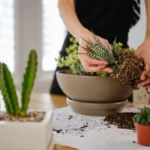Welcome to the world of herbs, where small plants make a big difference! Today, we’re going to focus on one particular herb that has been making waves for its amazing flavor and numerous health benefits – sage. Known for its robust flavor and striking grey-green leaves, sage is a delightful addition to many dishes. But how do you harvest sage without harming the plant? Let’s dive into that.
- FLAVOR – Sage is a great herb to dress up chicken, salmon, turkey, stuffing, soups, beans, and squash. It has a savory flavor.
- INDOOR & OUTDOOR HERB GARDEN – Sage (Salvia) is a great herb to grow inside your kitchen and outdoors.
- USA – All of our seeds, including the Sage seeds, are heirloom, open-pollinated and non-GMO, grown in the USA. Don’t buy inferior seeds from other countries. This should give you added reassurance that not only can you enjoy the seeds this season, but you can save the seeds each year, adding food security to your home.
- PACKETS – Each sage seed packet is printed on water-resistant paper, in full color, with growing and harvesting directions included. Each rosemary packet contains at least 200 mg of seeds.
- GUARANTEE – We know you’re absolutely going to love your sage seed, but if for any reason you don’t, please contact us.
Sage Plant
Before we go snipping away, it’s important to understand our lovely plant. Sage, or Salvia officinalis, is a perennial plant that thrives in well-draining soil and full sun. It has a bushy growth habit, often reaching around 2 feet in height. Sage’s woody stems are covered in oblong, velvety leaves that boast a stunning grey-green hue.
Recognizing the growth habit and structure of your sage plant is vital to a successful harvest. It’s a hardy plant, yes, but like all living things, it needs care and respect. So, let’s treat it well and make sure we harvest it in a way that ensures its continued growth and productivity.
When is the Right Time to Harvest Sage?
Timing is everything when it comes to harvesting herbs, and sage is no exception. The best time to harvest sage is in the morning after the dew has dried but before the sun gets too hot. This is when the plant’s essential oils, which give sage its aroma and flavor, are at their peak.
As for the right stage of the plant’s growth, sage can be harvested just before or as it begins to bloom. However, it’s good to know that sage is a perennial plant, meaning it comes back year after year. So, if you miss the initial harvesting window, don’t worry! Just make sure to avoid heavy harvesting in the first year to allow your sage plant to establish itself well.
Tools Needed for Harvesting Sage
Gardening is always easier when you have the right tools. Here’s what you’ll need to harvest your sage:
- Pruning Shears: Sharp and clean pruning shears make clean cuts, ensuring minimal damage to the plant.
- Gloves: Sage leaves can be a bit prickly, so it’s a good idea to protect your hands with a pair of gardening gloves.
- Basket or Bag: You’ll need something to put your harvested sage leaves in.
Before using the shears, make sure to clean them to avoid transferring any diseases to your sage plant. Now, we’re all set to harvest!
- Make Pruning Work Easier: Rust-resistant stainless steel blade are sharp and durable for easy and smooth cut.Anti-slip and ergonomic handle make the gardener clippers more comfortable in your hand.Easy-open spring action reduces hand fatigue while cutting. you can easily to cut without damaging the vital stems and branches of your plants
- User-friendly Safety Lock: These garden shears have locking mechanisms to keep the sharp blades securely closed when not in use.It is easy to maneuver and can effectively reduce accidental injuries. And the closing mechanism is firmly enough, you don’t need to worry the plant pruning shears will get locked accidentally during use
- Garden Gloves for Hand Protection: One size fits most. This Gardening gloves,made of soft & comfortable cotton fabric,can protect yourself from dirt, skin wounds and nasty splinters when doing yard chores. The grip latex coating provides anti-slip or sure control when grabbing garden & yard tools
- Widely Used: This gardening shears set comes with 3 different blades for a variety of general pruning tasks.It is ideal for harvesting or trimming herbs,flowers,house plants, hydroponics,bonsai,cutting stems or light branches,or other cutting needs in the garden. It would also be a perfect gift for a gardening friend
- Customer support: Please feel free to tell us if you have any questions about our garden shears pruning. Note:Keeping your pruner shears cleaned and well-oiled can extend their lifespan. Please dry and clean it after use. Note: The colors of the garden pruners and gloves will be shipped at random
Step-by-Step Guide on How to Harvest Sage
Now that we have the basics covered, let’s get down to the nitty-gritty. Follow these steps to harvest your sage in a way that promotes more growth and keeps the plant healthy:
- Choose the Right Stems: Look for stems that are mature, have numerous leaves, and are not flowering. This is usually the outer growth.
- Cut the Stems: Using your clean pruning shears, cut the stem about 4-6 inches from the top. It’s best to make your cut just above a pair of leaves. This encourages the plant to branch out and become bushier.
- Gather the Harvested Leaves: Collect the cut stems in your basket or bag.
That’s it! You’ve successfully harvested your sage without causing any harm to the plant.
Post-Harvest Care for Sage Plants
After you’ve harvested your sage, the plant might look a bit bare, but don’t worry. With proper care, it’ll bounce back in no time. Here are some post-harvest care tips for your sage plant:
- Watering: After harvesting, water your sage plant thoroughly. Sage plants prefer slightly dry conditions, but a good drink after a major trim can be beneficial.
- Pruning: Regular pruning encourages bushier growth. Remove old, woody stems to promote new growth.
- Winter Protection: If you live in a colder climate, protect your sage plant in the winter with mulch or a cover.
Remember, the key to a healthy and productive sage plant lies in good ongoing care. Treat your plant well, and it will reward you with plenty of delicious leaves to enjoy.
Frequently Asked Questions About Harvesting Sage
Even with all this knowledge, you may still have some questions about harvesting sage. Here are answers to some common ones:
Can I harvest sage all year round?
While sage is a perennial plant and doesn’t die off in the winter, its growth slows down significantly. It’s best to do your major harvesting in the spring and summer, leaving the plant to rest and rejuvenate in the cooler months.
How often should I harvest sage?
You can harvest sage as often as you need it, but remember not to take more than a third of the plant at a time. Allow the plant to recover and produce new growth before the next harvesting.
What should I do with harvested sage?
Harvested sage can be used fresh or dried. Fresh sage is great in many recipes. To dry sage, tie the stems in small bundles and hang them in a warm, dry place with good air circulation.
Conclusion
Harvesting sage doesn’t have to be a nerve-wracking process. With the right knowledge and a bit of practice, you can enjoy fresh sage from your own garden without harming your plant. Just remember to keep your plant healthy with good care practices and it will provide you with plenty of flavorful leaves for years to come. Happy gardening!





